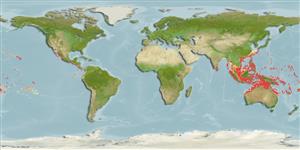>
Mulliformes (Goatfishes) >
Mullidae (Goatfishes)
Etymology: Parupeneus: Latin, parum, parvum = small + Peneus, the name of a river.
More on author: Bleeker.
Environment: milieu / climate zone / пределы глубины / distribution range
экология
морской ассоциированный с рифами; пределы глубины 1 - 100 m (Ref. 43239). Tropical; 30°N - 25°S
Western Pacific: Moluccas and Philippines to western Samoa, north to the Ryukyu Islands, south to New Caledonia and Tonga; Palau, Caroline and Marshall Islands in Micronesia. Recorded from Shark Bay, Western Australia (Ref. 115274).
Size / Вес / Возраст
половая зрелость: Lm ? range ? - ? cm
Max length : 30.0 cm TL самец/пол неопределен; (Ref. 9710); common length : 20.0 cm TL самец/пол неопределен; (Ref. 48636)
колючие лучи спинного плавника (общее число) : 8; членистые (мягкие) лучи спинного плавника (общее число) : 9; колючие лучи анального плавника: 1; членистые (мягкие) лучи анального плавника: 7. Diagnosis: Pectoral rays 15-16 (usually 15). Gill rakers 6-8 + 20-25 (total 28-32). Body moderately elongate, depth 3.2-3.5 in SL; head length 2.75-3.15 in SL; snout length 1.8-2.0 in HL; barbel length 1.3-1.5 in HL; head and anterior half of body reddish black, posterior half white and yellow with a black spot nearly as large as eye on upper side below rear base of second dorsal fin, followed by small blue spots; a white band from front of snout passing above eye along dorsal part of body, and a second nearly parallel one from corner of mouth to above pectoral fin; caudal fin pale yellow with a broad, dusky lower margin, and often with a small red spot at midbase; barbels red (Ref. 54393).
Body shape (shape guide): fusiform / normal; Cross section: oval.
Adults solitary, juveniles in schools (Ref. 90102). Usually found in the vicinity of coral reefs in protected waters such as bays or lagoons or in deeper outer-reef areas to at least 40 meters (Ref. 54393). Inhabits mixed sand, rubble, and seaweed covered bottoms near coral reefs. Carnivorous, feeds mainly on worms, crustaceans, brittle stars, and small mollusks and heart urchins.
Life cycle and mating behavior
половая зрелость | размножение | нерест | икра | Fecundity | личинки
Randall, J.E., 2004. Revision of the goatfish genus Parupeneus (Perciformes: Mullidae), with descriptions of two new species. Indo-Pac. Fish. (36):64 p. (Ref. 54393)
Статус Красного Списка МСОП (Ref. 130435: Version 2025-1)
Угроза для людей
Harmless
Использование человеком
рыболовство: коммерческий; аквариум: коммерческий
дополнительная информация
инструменты
Специальные отчеты
Скачать в формате XML
ресурсы в Интернет
Estimates based on models
Preferred temperature (ссылка
123201): 24.7 - 28.9, mean 27.6 °C (based on 732 cells).
Phylogenetic diversity index (ссылка
82804): PD
50 = 0.5000 [Uniqueness, from 0.5 = low to 2.0 = high].
Bayesian length-weight: a=0.01380 (0.00792 - 0.02405), b=3.13 (2.98 - 3.28), in cm total length, based on LWR estimates for this species & Genus-body shape (Ref.
93245).
Trophic level (ссылка
69278): 3.4 ±0.39 se; based on food items.
устойчивость к внешним воздействиям (ссылка
120179): средний (среднего размера), минимальное время удвоения популяции 1.4-4.4 года (Preliminary K or Fecundity.).
Fishing Vulnerability (Ref.
59153): Low vulnerability (20 of 100).
🛈
Nutrients (Ref.
124155): Calcium = 36.8 [18.5, 82.1] mg/100g; Iron = 0.322 [0.164, 0.711] mg/100g; Protein = 17.8 [14.4, 20.8] %; Omega3 = 0.133 [0.075, 0.241] g/100g; Selenium = 57.6 [27.7, 136.4] μg/100g; VitaminA = 200 [40, 841] μg/100g; Zinc = 0.562 [0.338, 1.065] mg/100g (wet weight);
